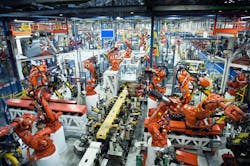The need to reshore critical manufacturing operations to the U.S. has long been a topic of discussion that’s been reignited recently due to COVID-19 and related supply chain disruptions. As Stephanie Neil, senior editor at Automation World, noted in her feature article “How Automation Enables Viable Reshoring”:
When the pandemic reached the U.S. in 2020, about half of the world’s disposable masks were produced in China. As COVID-19 became a global healthcare crisis, face masks became essential and countries imposed restrictions on exports, which increased the worldwide shortages of masks and raw materials, according to the U.S. National Institute of Health’s National Library of Medicine.
"All it took was stopping the supply of disposable masks produced overseas from coming to the U.S. for us to be critically impacted,” said Raphael Kryszek, founder and CEO of Intrepid Protect, a manufacturing start-up focused on producing face coverings made at a new state-of-the-art facility in Los Angeles, Calif. It was the PPE shortage, a dependence on foreign sourcing of goods, and a lack of quality-control standards that prompted Kryszek to make manufacturing in America a viable option.
As noted in Neil’s article, the use of automation will play a key role in the U.S.’s ability to effectively reshore critical manufacturing operations. Though this may seem to be an obvious observation, it raises the oft-cited concerns about automation replacing human workers.
Witnessing, as we all have over the past two years, how disruptions to shipping routes, overseas labor supplies and trade relationships affected our markets, Sheff says investments in automation make it possible for global manufacturers to build strong domestic supply chains close to their markets and, thereby, offset such disruptions.
He adds that greater use of automation can help reduce the fluctuations in manufacturing employment that have long been a concern of industrial workers—and have kept many potential workers away from the industry.
“When we see a reduction in [manufacturing] activity, in the short-term, manufacturers tend to reduce employee head counts,” says Sheff. “This can be economically dangerous because when we lose a skill, we’ll eventually need to replace it. The flexibility automation provides not only allows production to meet demand with fewer layoffs, but also allows companies to retain their most skilled and innovative workers through economic downturns.”
Sheff says the knock-on effect of using automation to reshore more manufacturing operations would shorten supply chains, utilize domestic suppliers with nearby inventories, and allow companies to keep less capital on hand, thereby becoming much more efficient.
“We cannot achieve these important goals without investing in automating our industries,” he says. “Strategic reshoring and industrial automation are, in fact, two sides of the same coin.”


